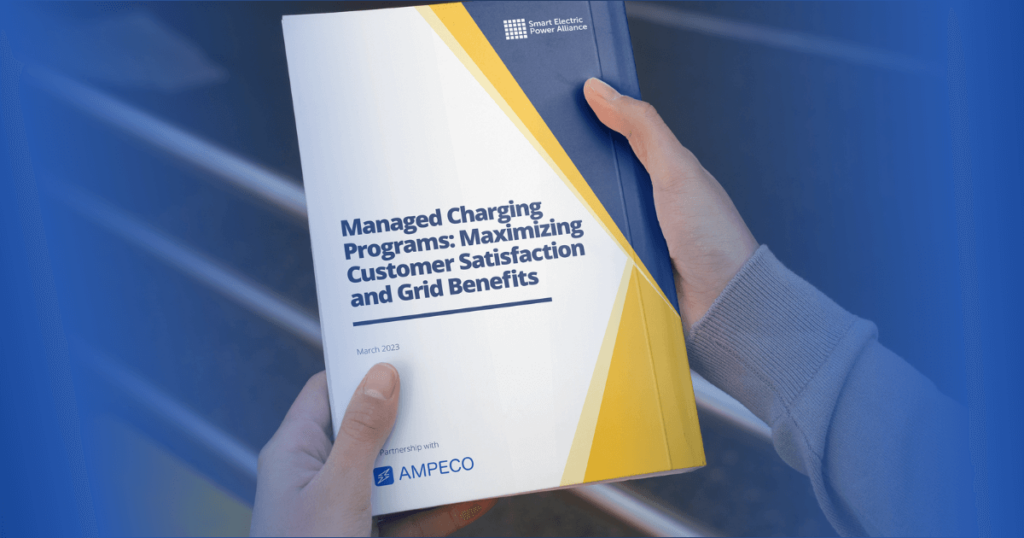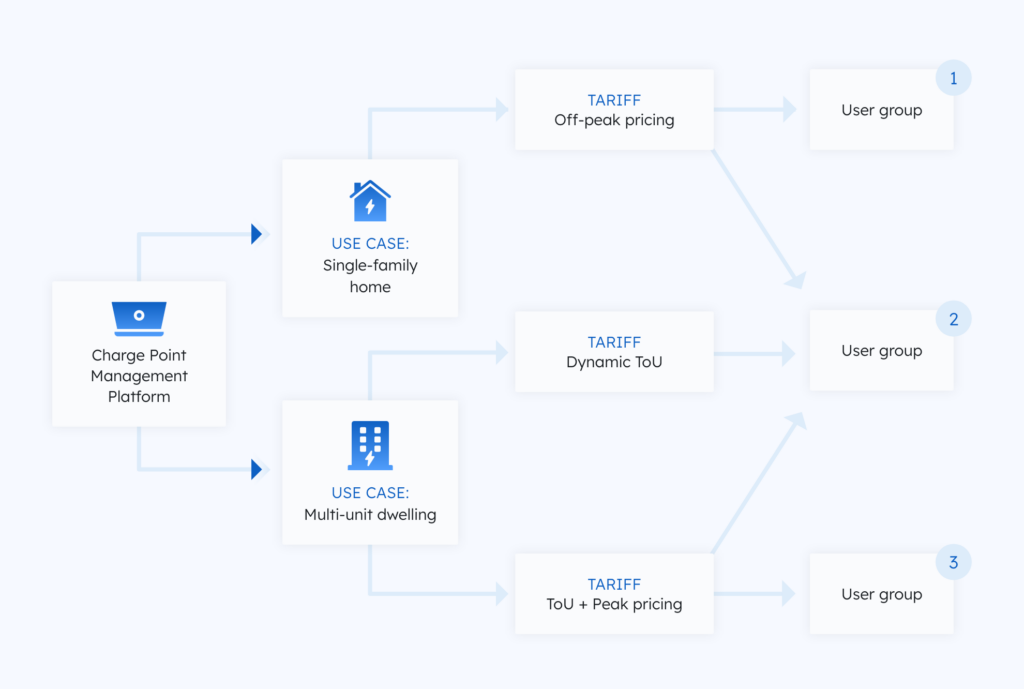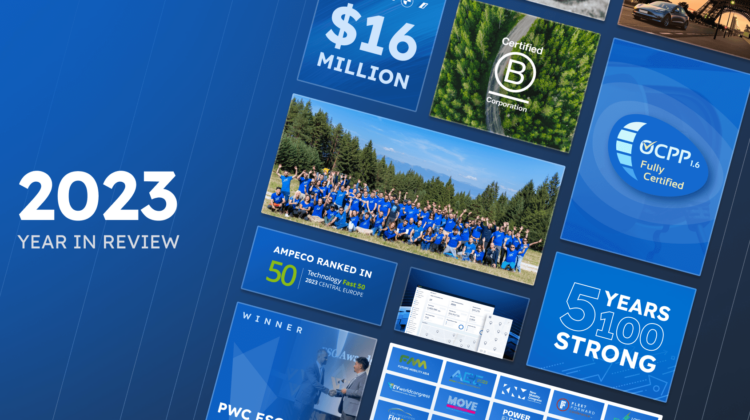Managed charging and its role in the electrification of transportation
As the world increasingly adopts electric vehicles (EVs), utility companies are taking proactive steps to integrate them smoothly with the grid. Managed charging programs enable grid-friendly charging behavior, such as time-of-use (TOU) rates and active managed charging and discharging. AMPECO recently partnered with The Smart Electric Power Alliance (SEPA) to publish a report, “Managed Charging Programs: Maximizing Customer Satisfaction and Grid Benefits,” on March 22nd, 2023.

AMPECO is a member of SEPA, a nonprofit organization dedicated to helping electric power stakeholders navigate the transition to a clean and modern energy future. SEPA conducted a comprehensive literature review to collect data and insights for this report in collaboration with AMPECO and several industry leaders, Kaluza, WeaveGrid, and Uplight, all of whom have significant expertise in managing EV charging programs and promoting grid stability. By leveraging the insights and expertise of these key industry players, utilities, and regulatory experts, the report provides valuable guidance for utilities looking to implement managed charging programs that deliver maximum benefits to both customers and the grid.

Learn about managed charging and its critical role in the electrification of transportation in SEPA’s latest report, developed in partnership with AMPECO and leading industry players.
Successful programs leverage EV customer and charging data
Current enrollment from managed charging programs worldwide has yet to meet their projected models, indicating ample room for growth. A recent global study by Parrish et al. found that three-quarters of managed charging initiatives had less than 33% target enrollment, and technology providers reported a 10% enrollment rate from multiple programs. The report suggests that best practices for program engagement goals can be used to increase customer participation, such as prioritizing customers who provide the highest value to the grid, addressing privacy and comfort concerns, and leveraging EV customer and charging data.
The report states that opt-out programs tend to have a higher enrollment rate than opt-in programs due to the convenience of the process. However, customer education is essential to avoid economic impacts caused by unfamiliarity with rate structures. The cost of opt-out programs may also be higher than the value provided.
Target customers who closely align with the program’s purpose
Managed charging programs play a crucial role in facilitating the transition to sustainable transportation. However, these programs can present challenges when it comes to recovering the return on investment. One solution is to prioritize customers who provide the most value to the grid, allowing for a quicker ROI. Incentivizing participation is another effective way to increase program enrollment.
Despite the potential benefits of managed charging programs, regulatory constraints can present a conflict between ROI expectations and high program enrollment. Many EV drivers may not produce significant load shift potential, making ROI recovery difficult. Incentivizing participation can be a successful strategy, particularly if existing utility programs are already in place. Studies have shown that initial incentives of $50 or $300 can convince 45% of EV owners to participate in managed charging programs. To target customers who provide the most closely aligned responses to the program’s purpose, AI-powered data analytics can help categorize the best-suited candidates for various managed charging programs. It’s clear that unlocking the full potential of managed charging programs involves thoughtful strategy and an understanding of the customer’s value to the grid.
AMPECO managed charging case studies
1. Case Study: Danish managed charging tax reimbursement
Denmark has implemented a tax reimbursement program for EV drivers who opt-in to networked charging, allowing smart charging at non-public stations. As a trusted EV charging software provider, AMPECO enables bundling smart charging with flexible tariff structuring, currently being applied by Danish customers operating 1,100+ public and private charging stations. The bundling allows for flexible tariffs based on dynamic electricity pricing derived from the Nordic power exchange. AMPECO’s technology calculates a complex charging schedule optimized based on dynamic pricing data and allows integrations with different incentive schemes. Since September 2021, more than 140,000 non-public charging sessions have been generated in Denmark, and at the end of each quarter, the platform generates an electricity tax reimbursement report for each user.
Key takeaways: The case study shows that a charging schedule based on flexible tariffs with dynamic electricity prices, coupled with clear financial incentives, results in close to 100% EV driver participation. This sustainable proposition helps decrease the carbon footprint of EV charging, reduce renewable energy curtailment, avoid local grid reinforcement expenditure, and reduce direct costs for drivers.
2. Case study: UK smart charge points
The UK Smart Charge Points Regulations require all private-use EV chargers sold since June 2022 to support smart functionality, including off-peak scheduling and randomized delay. The fully compliant AMPECO charging management software enables these functions, which are intended to ease grid pressure and reduce the risk of grid instability. Over 17,000 charging points operated by various network operators are connected to the AMPECO charging management platform and are fully compliant with UK regulations. The chargers are networked, and their data connectivity enables the measurement, recording, and transmission of intelligent remote signals.
Key takeaways: Due to its recent implementation, the regulations have yet to produce viable conclusions as there isn’t sufficient data to be conclusively analyzed. Preliminary findings suggest that 72% of users adhere to the default settings, and our platform allows easy override when needed. The regulation is a positive step towards a connected and decarbonized energy system. Similar regulations should be implemented in other service territories along with the implementation of open standards and protocols to facilitate communication within the ecosystem regarding power usage.
Looking to deepen your understanding of managed charging programs and their impact on the electrification of transportation? Check out this informative video where Petar Georgiev, Head of Partnerships and Sustainability at AMPECO, and Garrett Fitzgerald, Senior Director of Electrification at SEPA, dive into the topic and offer valuable insights on the subject with a special emphasis on effective strategies for increasing participation rates.
Effective managed charging programs offer a win-win for grid stability and EV drivers
Managed charging programs have a critical role in facilitating the electrification of transportation. Utility companies should continue to refine their managed charging programs. One approach utilities experiment with is collecting charging data and incentivizing participation among different customer segments. By defining and organizing tariffs tailored to each user group, customized pricing can be offered to increase customer engagement in managed charging. As the graph below indicates, this not only helps to boost participation rates but also accommodates multiple use cases and promotes equity in transportation electrification programs.

We are confident that with the right approach, customer engagement can be improved and the ROI on these programs realized. As the percentage of EVs on the road increases, managed charging initiatives will undoubtedly play an increasingly significant role.











